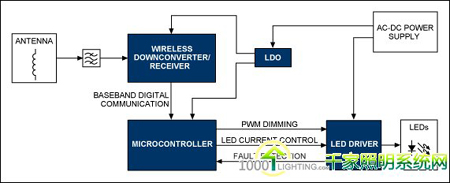Provides greater design flexibility for dimming and changing lighting colors, ideal for architectural lighting, interior lighting and dimming, energy efficient street lighting, and outdoor lighting applications where remote control of lighting is possible. These applications can bring great value to users, but in order to succeed in the market, the cost of upgrading lighting to LED technology must be kept to a minimum. There is no doubt that a solution that reuses existing infrastructure is inevitably the most popular option.

In remote control applications, the infrastructure with the highest product upgrade cost is to control LED lighting wiring. Fortunately, there are two techniques that can be used to eliminate this expensive upgrade: PLC technology can support long-distance communication, but it can cause problems when the circuit breaker or transformer of the AC line does not allow free flow of data. Although there is no such problem in wireless communication, the communication frequency is limited to the license-free band, and the wireless communication distance is also limited. In some cases, the two technologies can be combined to get the best solution: power line communication without transformer blocking and cross-transformer design with wireless connectivity.
The main design requirements for remote control of LED lighting include: communication range. Depending on the specific application, for residential indoor applications, a communication range of around 30m can meet the requirements, and street lights require several kilometers of communication range. Low power consumption. An important selling point for LEDs is energy efficiency. Turn off the illumination, and only ensure that the LED lamp has the lowest power consumption when the communication line remains active. This is critical for design. Communication rate. Some lighting applications require only a low communication rate (several kbps) to meet dimming control and fault status reading requirements. However, architectural lighting sometimes requires very high data rates, even up to 100 kbps. Wall washers are a typical example of this type of application. Multiple lights are controlled by a single bus and the color of the lights needs to be constantly changed. low cost. Most lighting applications have similar requirements.

Typical wireless control lighting system block diagram

Typical PLC control lighting system block diagram
The remote control lighting system typically includes a microcontroller that can be a discrete unit or integrated inside another. In most cases, a basic microcontroller is sufficient, unless the system uses complex communication protocols and complex stacks (such as ZigBee). The controller is responsible for handling communication protocol decoding, LED driver dimming signals, reading fault conditions, etc., and is used to control the lighting effects of the lights (eg theater dimming).
For wireless applications in lighting applications, Maxim's MAX1473 receiver and MAX1472 transmitter are available. These products operate in the 300MHz to 450MHz license-free band and can communicate from 30m to 50m in indoor environments. The MAXQ610 microcontroller offers all of these essential features at a very low cost.
For PLC applications, Maxim's solutions include the MAX2991 analog front end (AFE) and the MAX2990 baseband processor. These devices form a complete power line transmit/receive chipset that can transmit data over a 10km power line at data rates up to 100kbps. This transmission distance makes it ideal for street lighting systems. The MAX2990 integrates a microcontroller with an output to control the PWM dimming input of the LED driver. This feature eliminates the need for other circuits that produce dimming signals.
Â
Solar cables are available for indoor and outdoor use for flexible and fixed installations with high mechanical strength in extreme weather conditions.
The cables are designed to withstand the harsh environmental conditions that occur in any fixed, mobile, rooftop or building integrated PV installation.
Applications
Solar energy is used to generate photovoltaic (PV) power by capturing sunlight. The energy is used for solar heating and, thanks to energy conversion, it can also be used to generate electricity. As a result, the demand for solar cables is also increasing. Solar cables are interconnecting cables used in photovoltaic power generation. Solar cables interconnect the solar panels and other electrical components of the PV system. Solar cables are designed to be UV-resistant and weatherproof.
Cable construction
Conductor: fine wire tinned copper conductor.Insulation: UV-resistant, cross-linkable, halogen-free, flame-retardant compound for core insulation.
Core marking: red, black or natural Sheath: UV-resistant, cross-linkable, halogen-free, flame-retardant compound for the insulation sheath.
Cable colour: black or red
Advantages
Solar cable modules operate at high temperatures and are exposed to a wide range of environmental conditions.These cables need to meet the sunlight resistance and temperature ratings required by the environment.
Solar cables are manufactured for photovoltaic applications.
Both cable types typically contain XLPE insulation and are resistant to sunlight and/or direct burial.
Solar Cable,Red Tuv Solar Cable,Pvc Copper Electrical Solar Cables,Solar Copper Wire Cable
Ruitian Cable CO.,LTD. , https://www.rtpowercable.com